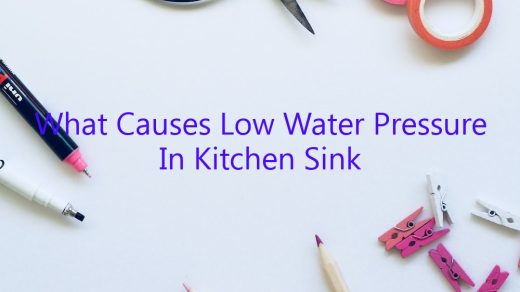Caulking your kitchen sink is an important and often overlooked task that can help keep your sink looking new and protect it from water damage. Follow these simple steps to caulk your kitchen sink like a pro!
1. Remove the old caulk. Use a sharp utility knife to cut through the old caulk and peel it away from the sink. Be careful not to damage the sink itself.
2. Clean the surface. Wipe down the sink and surrounding area with a damp cloth to remove any dust or debris.
3. Apply a new bead of caulk. Use a caulking gun to apply a new bead of caulk around the edge of the sink.
4. Smooth it out. Use a damp finger or a piece of cardboard to smooth out the caulk.
5. Let it dry. Let the caulk dry for at least 24 hours before using the sink.
Contents
Are you supposed to caulk a kitchen sink?
A kitchen sink is a key part of any kitchen. It is important to keep it in good condition so that it can function properly. One question that people often have is whether they are supposed to caulk a kitchen sink.
There are a few things that you should keep in mind when it comes to caulking a kitchen sink. The most important thing is that you should only caulk the sink if it is leaking. If it is not leaking, then there is no need to caulk it. Caulking a sink that is not leaking can actually cause more problems than it solves.
Another thing to keep in mind is that you should only use silicone caulk to caulk a kitchen sink. Other types of caulk can actually damage the sink. Silicone caulk is the best type of caulk to use for this purpose because it is durable and will not damage the sink.
If you do decide to caulk your kitchen sink, there are a few things that you need to do to ensure that the caulk lasts as long as possible. The first thing is to make sure that the surface of the sink is clean and dry. The second thing is to make sure that the caulk is applied in a thin line. If the caulk is applied too thick, it will not dry properly and will not last long.
If you follow these tips, you can ensure that your kitchen sink is properly caulked and will not leak.
What is the best caulking to use around a kitchen sink?
When it comes to caulking around a kitchen sink, there are a few things you need to consider. The most important factor is the type of caulk you use. Different caulks are designed for different purposes, so it’s important to choose the right one.
In general, there are two types of caulks: silicone and latex. Silicone caulks are more durable and resist moisture better than latex caulks. They’re also less likely to shrink or crack over time. However, silicone caulks can be more expensive and can be difficult to apply.
Latex caulks are less durable and less resistant to moisture than silicone caulks, but they’re also less expensive and easier to apply. Latex caulks are a good choice for most kitchen sink applications.
When choosing a latex caulk, it’s important to select a product that is specifically designed for use around sinks and counters. There are a few different types of caulk that fit this description, including silicone/latex caulk and acrylic latex caulk.
To apply latex caulk around a kitchen sink, start by removing the old caulk. Be sure to clean the area thoroughly and remove any debris or dust. Then, apply the caulk to the area and use a caulking gun to seal it in.
If you’re using silicone caulk, be sure to follow the manufacturer’s instructions for application. Silicone caulks can be difficult to apply, so it’s important to take your time and make sure the caulk is evenly distributed.
Once the caulk is in place, allow it to dry for 24 hours before using the sink.
How do you prepare a kitchen sink for caulking?
Caulking is a necessary step in protecting your kitchen sink from water damage. It is a sealant that is applied around the edges of your sink to prevent water from seeping into the cracks and seams. If caulking is not applied correctly, it can lead to water damage and expensive repairs. Here is how to properly prepare your kitchen sink for caulking:
1. Clean the sink thoroughly. Remove all dirt, grease, and soap residue.
2. Dry the sink completely.
3. Apply a coat of silicone caulk to the edges of the sink.
4. Smooth the caulk with a damp finger.
5. Allow the caulk to dry completely.
6. Apply a second coat of caulk, if desired.
7. Allow the caulk to dry completely.
8. If necessary, seal the caulk with a sealant sealant.
Applying caulking around your kitchen sink is a quick and easy way to protect it from water damage. By following these simple steps, you can ensure that your sink is properly caulked and protected from the elements.
How do I seal the gaps around my kitchen sink?
There are a few ways to seal the gaps around your kitchen sink. You can use caulk, silicone sealant, or expanding foam.
Caulk is a sealant that comes in a tube. You can use it to fill in small gaps around your kitchen sink. Caulk is easy to use and it dries quickly.
Silicone sealant is a sealant that comes in a tube or a can. It is thicker than caulk and it is more durable. Silicone sealant is a good choice for sealing larger gaps around your kitchen sink.
Expanding foam is a sealant that comes in a can. It is a good choice for sealing small gaps around your kitchen sink. Expanding foam is easy to use and it dries quickly.
Should I use white or clear caulk?
When it comes to caulking, there are a few different types to choose from. The two most popular types are white and clear. So, which one should you use?
The answer depends on the purpose of the caulking. If you are caulking around windows or doors, then clear caulk is the better option. This is because it allows the natural light to pass through, which makes the area look more natural.
However, if you are caulking cracks or seams, then white caulk is the better option. This is because it is more visible and will help to conceal the cracks or seams.
Can You Use Flex seal on kitchen sink?
Can You Use Flex seal on kitchen sink?
There is no definitive answer to this question as Flex seal is a multipurpose sealant that can be used on a variety of surfaces. However, it is always advisable to test a small area of the surface first to ensure the sealant does not cause any damage. In general, Flex seal is a good choice for waterproofing and sealing kitchen sinks, as it is a durable and long-lasting product.
What is the difference between caulk and silicone?
Caulk and silicone are both substances used for sealing and waterproofing. They are both made from silicone, but there are some key differences between them.
Caulk is a pliable material that can be applied easily, and it dries quickly to form a watertight seal. However, it is not as durable as silicone and can deteriorate over time.
Silicone is a more durable material that can withstand extreme temperatures and weather conditions. It is also less likely to deteriorate over time. However, it is more difficult to apply than caulk and can be messy.




